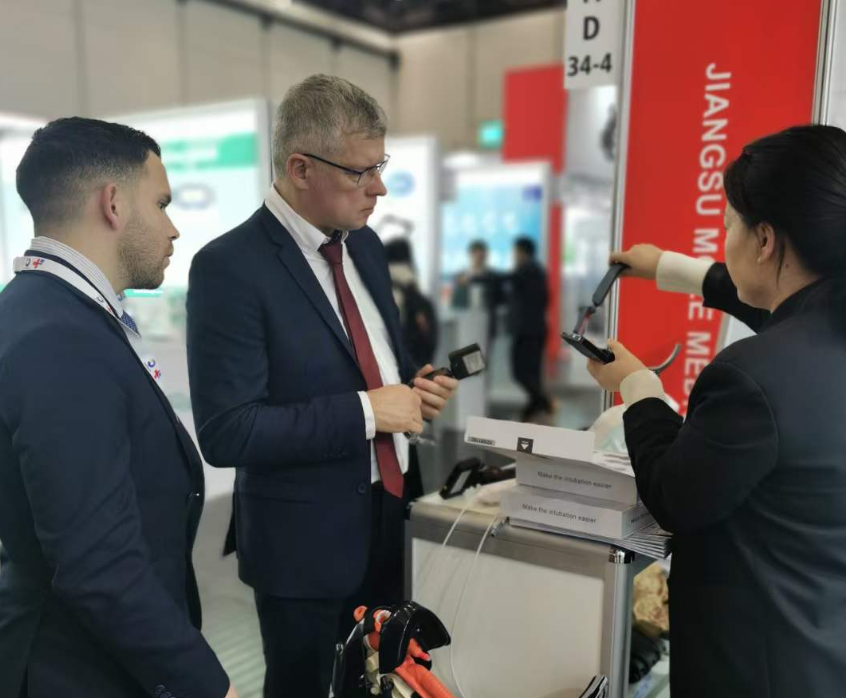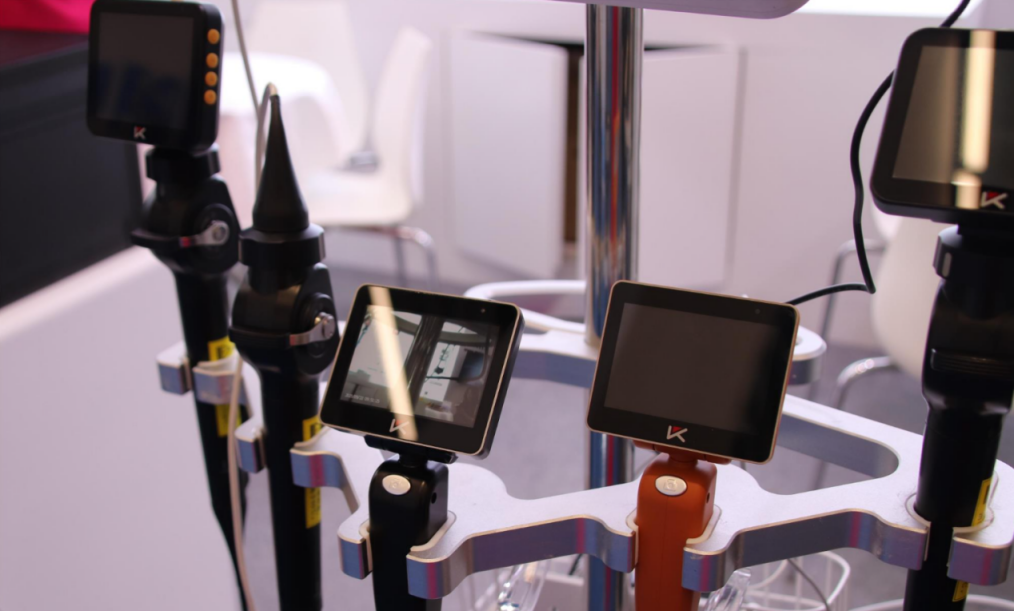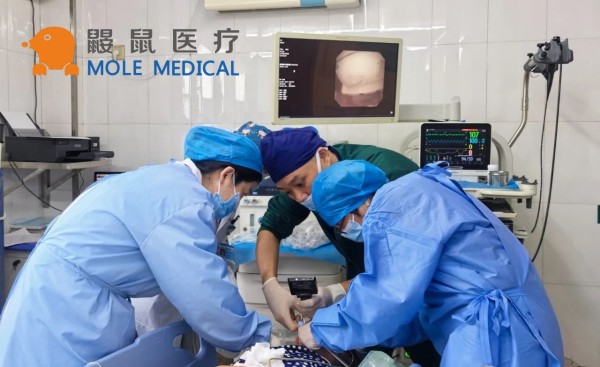Flexible Video Laryngoscopes: Innovating Airway Management for Better Patient Outcome
Apr 16, 2024
The flexible video laryngoscope represents a significant advancement in medical technology, particularly in airway management. Developed by leading medical equipment manufacturer Mole Medical, this device offers healthcare professionals enhanced visualization and maneuverability during intubation procedures. It consists of a flexible insertion tube equipped with a miniature camera and light source, allowing for clear visualization of the airway anatomy. Unlike traditional laryngoscopes, which typically have a rigid design, the flexibility of the video laryngoscope enables it to navigate through challenging airways with greater ease and precision.
Introduction to Flexible Video Laryngoscope
1. Components and Functionality
The flexible video laryngoscope comprises several key components, including the insertion tube, camera module, light source, and handle. The insertion tube is made of flexible material, allowing it to bend and maneuver through the patient’s airway. At the distal end of the tube is the camera module, which houses a high-definition camera capable of capturing detailed images of the airway structures. The light source illuminates the area being examined, ensuring optimal visibility during intubation. The handle, typically held by the healthcare professional, houses controls for manipulating the scope and adjusting camera settings.
2. Enhanced Visualization
One of the primary advantages of the flexible video laryngoscope is its ability to provide improved visualization of the airway anatomy. The high-definition camera captures clear images, allowing healthcare professionals to accurately identify anatomical landmarks such as the vocal cords and epiglottis. This enhanced visualization reduces the risk of complications during intubation procedures, as it enables precise placement of the endotracheal tube.
3. Enhanced Maneuverability
The flexibility of the video laryngoscope enables it to navigate through difficult airways more effectively than traditional laryngoscopes. Its slender profile and articulating tip allow for greater maneuverability, even in patients with limited mouth opening or restricted neck mobility. This feature is particularly beneficial in emergency situations, where rapid and accurate airway management is essential for patient survival.
4. Reduced Patient Discomfort
The design of the flexible video laryngoscope minimizes patient discomfort during intubation procedures. Unlike rigid laryngoscopes, which may cause trauma to the soft tissues of the airway, the flexible insertion tube of the video laryngoscope is gentler on the patient’s anatomy. This reduces the risk of complications such as bleeding or swelling, enhancing patient safety and comfort during the intubation process.
5. Versatility
The flexible video laryngoscope is versatile and can be used in a variety of medical settings and scenarios. In emergency medicine, it plays a crucial role in managing airways during traumatic injuries, cardiac arrest, and other life-threatening situations. In anesthesiology, it aids in intubation procedures for patients undergoing surgery, ensuring smooth and efficient airway management. In critical care settings such as the intensive care unit (ICU), it is invaluable for managing the airways of critically ill patients who may have complex medical conditions or compromised anatomy.
Applications in Medical Practice
1. Emergency Medicine
In emergency medicine, time is of the essence, and the flexible video laryngoscope provides healthcare professionals with the tools they need to quickly and effectively manage airways in critical situations. Whether dealing with traumatic injuries, cardiac arrest, or respiratory emergencies, the device’s enhanced visualization and maneuverability allow for rapid and accurate intubation, ultimately improving patient outcomes.
2. Anesthesiology
In the operating room, the flexible video laryngoscope is a valuable asset for anesthesiologists performing intubation procedures prior to surgery. Its ability to navigate through difficult airways with ease reduces the risk of complications and ensures that patients receive the anesthesia they need safely and efficiently. Additionally, its clear visualization capabilities enable anesthesiologists to confirm correct tube placement, minimizing the risk of intraoperative complications such as aspiration or hypoxia.

3. Critical Care
In the ICU, critically ill patients often present with complex medical conditions and compromised airways. The flexible video laryngoscope allows critical care teams to effectively manage these airways, even in challenging circumstances. Whether performing routine intubations or managing unplanned extubations, the device’s versatility and reliability make it an indispensable tool for critical care providers.
4. Pediatrics
Pediatric patients present unique challenges when it comes to airway management, and the flexible video laryngoscope is well-suited to address these challenges. Its slender profile and flexible design make it easier to maneuver in the smaller airways of pediatric patients, reducing the risk of trauma and complications. Additionally, its enhanced visualization capabilities ensure that healthcare professionals can accurately assess and manage pediatric airways, even in high-stress situations.
Comparison with Traditional Laryngoscopes
1. Design Differences
Traditional laryngoscopes have long been the standard tool for intubation, consisting of a rigid blade with a handle that is inserted into the patient’s mouth to visualize the airway. In contrast, flexible video laryngoscopes, such as those manufactured by Mole Medical, feature a flexible insertion tube equipped with a miniature camera and light source. This design allows for greater maneuverability and visualization, as the scope can navigate through difficult airways with ease. Additionally, while traditional laryngoscopes require direct line-of-sight to the vocal cords, flexible video laryngoscopes provide a video feed that can be viewed on a monitor, allowing for clearer visualization of the airway anatomy.
2. Advantages Over Traditional Laryngoscopes
Flexible video laryngoscopes offer several advantages over their traditional counterparts. One of the most significant benefits is improved visualization of the airway anatomy. The high-definition camera provides clear images of the vocal cords and surrounding structures, allowing healthcare professionals to accurately assess the airway and guide the placement of the endotracheal tube. This reduces the risk of complications such as esophageal intubation or trauma to the airway tissues.
Another advantage of flexible video laryngoscopes is reduced trauma risk. Traditional laryngoscopes can cause discomfort and injury to the patient’s mouth and throat due to their rigid design. In contrast, the flexible insertion tube of video laryngoscopes is gentler on the patient’s anatomy, minimizing the risk of complications such as bleeding or swelling. This is particularly important in patients with delicate airways or those at higher risk of complications, such as the elderly or critically ill.
3. Limitations
While flexible video laryngoscopes offer many advantages, they are not without limitations. One limitation is the cost associated with purchasing and maintaining the equipment. Flexible video laryngoscopes are typically more expensive than traditional laryngoscopes, making them less accessible to some healthcare facilities. Additionally, the technology may require specialized training for healthcare professionals to use effectively, which can further increase costs and resource requirements.
Technological Advances and Innovations
1. Evolution of Flexible Video Laryngoscopes
Over the years, flexible video laryngoscopes have undergone significant technological advancements to improve their design and functionality. Early models were often bulky and cumbersome, with limited maneuverability and image quality. However, advances in miniaturization and camera technology have led to the development of more compact and user-friendly devices. Modern flexible video laryngoscopes, such as those manufactured by Mole Medical, offer high-definition imaging and enhanced maneuverability, allowing for more precise and efficient airway management.
2. Integration with Other Technologies
Flexible video laryngoscopes have the potential to be integrated with other medical technologies to further enhance their capabilities. For example, augmented reality (AR) technology could overlay anatomical landmarks onto the video feed, providing real-time guidance for healthcare professionals during intubation procedures. Similarly, artificial intelligence (AI) algorithms could analyze the video feed to assist with airway assessment and tube placement, improving the accuracy and efficiency of the intubation process.

3. Future Prospects
Looking ahead, the future of flexible video laryngoscope technology looks promising. Continued advancements in miniaturization, imaging, and connectivity are expected to further improve the performance and usability of these devices. Additionally, ongoing research and development efforts may lead to new features and functionalities that enhance the safety and efficacy of airway management procedures. With the increasing demand for minimally invasive and technologically advanced medical devices, flexible video laryngoscopes are likely to play a crucial role in the future of airway management.
Clinical Considerations and Best Practices
1. Training and Education
Proper training and education are essential for healthcare professionals using flexible video laryngoscopes. Training programs should cover device operation, airway anatomy, and intubation techniques to ensure competency and proficiency. Hands-on simulation training can provide valuable experience in navigating difficult airways and managing potential complications. Additionally, ongoing education and skills maintenance are necessary to stay up-to-date with advances in technology and best practices in airway management.
2. Patient Selection
When selecting patients for flexible video laryngoscopy, healthcare professionals should consider factors such as airway anatomy, medical history, and procedural complexity. Patients with difficult airways, anatomical abnormalities, or a history of previous airway complications may benefit most from the use of flexible video laryngoscopes. Additionally, patients undergoing high-risk procedures or those who are unable to tolerate traditional laryngoscopy may also be suitable candidates for flexible video laryngoscopy.
3. Safety Measures
To minimize risks during procedures, healthcare professionals should follow established safety protocols and best practices when using flexible video laryngoscopes. This includes proper patient positioning, preoxygenation, and monitoring of vital signs throughout the procedure. Additionally, regular equipment maintenance and inspection are essential to ensure device functionality and reliability. In the event of complications or difficulties during intubation, healthcare professionals should be prepared to quickly switch to alternative airway management techniques to ensure patient safety.
4. Case Studies
Numerous case studies have demonstrated the effectiveness of flexible video laryngoscopes in a variety of clinical settings. For example, a study published in the Journal of Emergency Medicine reported successful intubation using a flexible video laryngoscope in patients with difficult airways due to trauma or obesity. Similarly, a case series published in the Annals of Intensive Care described the use of flexible video laryngoscopy in critically ill patients with acute respiratory failure, highlighting its utility in managing complex airway scenarios. These cases illustrate the valuable role that flexible video laryngoscopes play in improving patient outcomes and safety in airway management.
Conclusion
In conclusion, the flexible video laryngoscope represents a significant advancement in airway management technology. Manufactured by Mole Medical, this innovative device offers healthcare professionals improved visualization, enhanced maneuverability, and reduced patient discomfort during intubation procedures. With applications across a wide range of medical specialties, from emergency medicine to critical care, the flexible video laryngoscope has become an essential tool for ensuring optimal patient outcomes in airway management.
Categories
Latest Articles

Disposable Nephroscopes: Redefining Safety & Efficiency in Urology
Introduction The shift towards minimally invasive urological surgery has found a pivotal ally: the disposable nephroscope. As traditional reusable scopes grapple with persistent biofilm contamination risks and soaring sterilization costs, the global medical community is rapidly adopting single-use solutions. This article analyzes the clinical value, technological evolution, and dynamic innovation landscape driving this transformative shift. ... Read more

Disposable Video Laryngoscope Blades: The Ultimate Solution for Preventing Cross-Contamination
In the operating room, as the cold light of a video laryngoscope illuminates a patient’s airway, an age-old medical challenge is being redefined: How can life-saving instruments avoid becoming vectors of infection? Jiangsu MoleMedical drives an innovative safety revolution—replacing reusable devices with single-use, sterile laryngoscope blades that create a pure barrier for critical airways. Traditional video ... Read more
-2.jpg)
FDA & CE Approved Video Laryngoscope: What Makes It Stand Out?
Introduction In high-pressure emergencies and precision-driven operating rooms, video laryngoscopy is revolutionizing airway management. Mole Medical’s FDA and CE-certified technology replaces tactile-dependent “blind intubation” with real-time visual navigation – enhancing safety, accuracy, and clinical outcomes worldwide. Why Certification Matters Mole Medical’s dual certifications validate its global compliance and performance: FDA Clearance: Rigorous validation of safety/efficacy ... Read more

Mole Medical Showcases Advanced Endoscopy Solutions at CMEF Autumn 2025, Driving Global Partnerships
Guangzhou, China – September 26-29, 2025 – The 92nd China International Medical Equipment Fair (CMEF Autumn) concluded successfully on September 29th at the Canton Fair Complex in Guangzhou. Mole Medical Technology Co., Ltd. (Mole Medical) made a significant impact at the event, drawing global medical professionals and partners to its booth (Hall 2.1, Stand Q24) ... Read more

How to Use Disposable Ureteroscopes Safely and Efficiently
In the field of urology, the application of disposable electronic ureteral-kidney pelvis endoscopy catheters is leading the technological innovation in minimally invasive surgeries. According to the 2024 multi-center research data from China’s urology department, among the over 5,000 surgeries included, the patient group using disposable catheters performed significantly better in key indicators such as operation ... Read more



